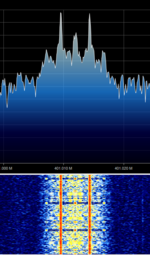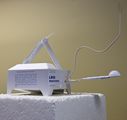Lockheed Martin LMS-6 (Radiosonde)
The LMS-6 is a radiosonde developed by Lockheed Martin which contains a temperature, barometric pressure (On the 1680 MHzMegaHertz (MHz) 10^6 Hz models only), and humidity sensor for upper air weather observations. It also contains a GPS receiver for position tracking as well as calculating wind speeds.
Currently in the United States, the National Oceanic and Atmospheric Administration (NOAA) is in the process transitioning some of it's National Weather Service (NWS) offices that are part of the upper-air observation program to the Graw DFM-17 radiosonde. Other offices are being transitioned to different variations of the Vaisala RS-41 Radiosonde A list of upper-air sites and their new radiosonde types can be found here on the weather.gov website.
Samples[edit]
403 MHzMegaHertz (MHz) 10^6 Hz:
1680 MHzMegaHertz (MHz) 10^6 Hz:
Frequencies & Power[edit]
- 400 MHzMegaHertz (MHz) 10^6 Hz Version: 16 settings between 400.250 and 405.875 with a step of 375 kHzKiloHertz (kHz) 10^3 Hz
- 1680 MHzMegaHertz (MHz) 10^6 Hz Version: 1676 MHzMegaHertz (MHz) 10^6 Hz, 1678 MHzMegaHertz (MHz) 10^6 Hz, 1680 MHzMegaHertz (MHz) 10^6 Hz, or 1682 MHzMegaHertz (MHz) 10^6 Hz
Both variants appear to have approximately 60mW of power

